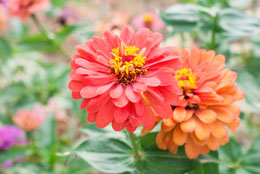Bring a multitude of vibrant colors home by sowing zinnia flower seeds. This article will tell you how to harvest and sow these seeds.

Zinnia is a genus of 20 species of annual and perennial plants of the family
Asteraceae. Native to American soil, zinnias have been hybridized into a vast number of cultivars and varieties that have made them a favorite bedding flower. Zinnia plants are slightly bushy in nature, and grow 6-40 inches in height. The blooms are single or double, in varying sizes, and in an array of wide-ranging colors. The sheer beauty that a zinnia can produce in mass bedding is almost impossible to replicate with any other type of flowers.
These flowers are summer annuals, hence can only be propagated through seeds that develop towards the end of the petal, and are entrained in the flower head itself. They are brown in color, and papery in texture. These seeds may seem delicate, but they have the potential to germinate fast and with little failure. Although zinnia seeds are easily available in almost all varieties, saving them and starting a flower plant from your own collection definitely has its own charm.
Seed Harvesting
For any seed to germinate, certain environmental conditions need to be satisfied, and these seeds are no exception. How well the seeds are harvested, stored, and finally sowed is exhibited through healthy plants and a good flower show. Harvesting and sowing time too play a vital part in ensuring a vigorous growth. To collect zinnia seeds from flowers, earmark some good quality flowers on the plant itself. Let the flower dry naturally on the plant. One can collect different colors and shades together or separately, depending on the color scheme you want to follow next season.
De-head the dried flower from the stem. The seed heads are at the center of the flower (they hold the petals down). On a clean large sheet, shake off the dried petals from the dead head. The dried petals, along with zinnia seeds, will fall off. With a light breath, blow away the chaff from the seeds. The seeds will be brown and dried. Store them either in a clean sterilized jar or in a paper mesh bag, and keep it in a cool dry place. Keep a check on them from time to time to rule out any fungal growth or infection. Some people prefer to dust a germicide powder on the seeds, but it is optional. While storing zinnia flower seeds, make sure no seed is green or damp.
Seed Planting
Zinnia seeds can be sown directly in the intended location and thinned later, or started indoors and seedlings planted accordingly. Zinnia look attractive in flowers beds, or even as edgings or borders. The tall varieties make bright temporary hedges too. Dwarf hybrid zinnia plant varieties can be easily grown in pots and containers of various sizes. Start the seeds indoors in early summers. The sowing medium should be light and well drained. Sprinkle seeds evenly and cover them lightly with soil. Spritz some water on it until the top soil dampens. Cover with a newspaper or a plastic wrap, and keep it in a shaded place. Ensure moisture to kick-start their seed germination process.
The seeds will sprout within a week's time. Expose the seedlings to sunlight gradually, and once they reach the six leaf stage, transplant them in rich organic compost added soil. Space them four inches to one foot apart, depending upon the variety. Water them adequately; although these plants do not like too much moisture, they will not tolerate dry spells either. Mulch around to keep the weeds away. Fertilize lightly when the buds being to appear. Regularly remove flower deadheads to prolong the profusion.
As the flowers begin to fade away, hold on to them for collecting seeds for the next season, and you can enjoy these blooms year after year without buying new seeds.






 Zinnia is a genus of 20 species of annual and perennial plants of the family Asteraceae. Native to American soil, zinnias have been hybridized into a vast number of cultivars and varieties that have made them a favorite bedding flower. Zinnia plants are slightly bushy in nature, and grow 6-40 inches in height. The blooms are single or double, in varying sizes, and in an array of wide-ranging colors. The sheer beauty that a zinnia can produce in mass bedding is almost impossible to replicate with any other type of flowers.
Zinnia is a genus of 20 species of annual and perennial plants of the family Asteraceae. Native to American soil, zinnias have been hybridized into a vast number of cultivars and varieties that have made them a favorite bedding flower. Zinnia plants are slightly bushy in nature, and grow 6-40 inches in height. The blooms are single or double, in varying sizes, and in an array of wide-ranging colors. The sheer beauty that a zinnia can produce in mass bedding is almost impossible to replicate with any other type of flowers.